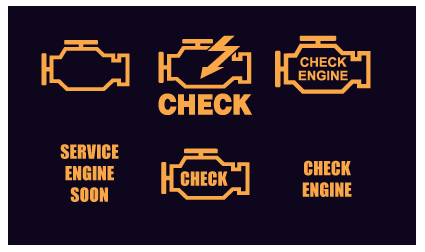Do you know what to do if your check engine light comes on? Do any new drivers in your household know what to do?
Well here are some basic steps and information that can help you to be prepared in case your check engine light comes on.
- Know what your check engine light looks like.
First, you need to be sure that you know what your check engine light looks like and where it is. The check engine light is located on your dashboard where the instrument lights are. Different cars use different identifiers, so be sure to check out your vehicle manual so that you know exactly what your check engine light looks like. Chances are it will look something like one of the pictures below. - Is the check engine light flashing?
If your check engine light is flashing, you will need to stop driving as soon as possible. If you don’t you risk incurring catalyst damage which could be very expensive to repair. Call a tow truck to have your car towed to your repair facility. - If your check engine light comes on and stays on…
The check engine light comes on whenever the On-Board Diagnostics – Generation II (OBD II) computer detects a problem. This OBD II computer package has been installed in cars since 1994 and is designed to be an early warning system. It will come on whenever either the engine tailpipe or evaporative (fuel system) emissions exceed industry standards. It can be activated by something serious or something as simple as you not replacing the gas cap tightly enough. Make sure you completely secure the cap any time you stop for gas. So… if your check engine light comes on and you are not experiencing any drivability problems, you can most likely continue driving without causing any damage (except to the environment of course). You should schedule a visit to your repair shop as soon as possible. - What we do.
When you bring your car in because the check engine light has come on, the first thing we do is hook your car up to a computer so that we can scan for codes. Codes identify the system at fault that put the light on. They provide a general idea of the problem area. We do this first scan test as a courtesy so we can give you an idea of what the next diagnostic step will be. The technician then looks at the information behind the code, looks at a snap shot of the data when the check engine light came on, and takes an in-depth look at the live sensor data. This includes things like vehicle speed, the position of the gas pedal, the temperature of the engine, etc.The technician’s next step is to interpret the data that’s been collected and check for service updates and recalls. All this information is used to develop a diagnosis report that the service writer uses to estimate the cost of the repair.Once the vehicle is repaired, we reset the computer. This means that the computer has to re-establish a baseline of performance data for your car. That’s why you need to postpone doing an emissions test following a computer reset for at least two weeks.







0 Comments